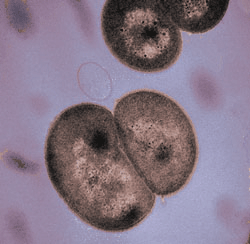| |
 |
Deinococcus geothermalis is
an extremely radiation resistant, moderately thermophilic bacterium closely
related to the mesophilic Deinococcus radiodurans. D. geothermalis is
culturable on defined minimal medium and undefined rich medium, and is
transformable with expression vectors originally constructed for D.
radiodurans. Draft sequencing of D. geothermalis together
with the recently reported advances in the genetic management of this organism
will facilitate its development for fundamental and practical objectives
that are relevant to the Science Missions of the DOE, and will provide
a deeper understanding of Deinococci-specific features in general.
Draft-genome comparisons are ongoing, with the first results published
in Daly et al 2004 (Science. Sep 30, 2004), and the complete
genome sequence is being assembled at Los Alamos National Laboratory. D.
geothermalis (1) is remarkable not only for its extreme resistance
to ionizing radiation, but also for its ability to grow at temperatures
as high as 55 degC (1) and in the presence of chronic irradiation (50 Gy/hour)
(2). The organism was isolated by Ferreira et al (1997) (1) from
thermal springs at Agnano, Naples, Italy. D. geothermalis belongs
to the bacterial family Deinococcaceae, currently comprised of
eight distinct nonpathogenic radiation resistant species, of which Deinococcus
radiodurans strain R1 is the most characterized (3). Advances in genetic
engineering for D. radiodurans (4) were a stimulus for its genome
sequencing (5), annotation (3), and transcriptome analyses (6), and the
genome sequence of D. geothermalis will make possible similar
work in this organism. In 2003, D. geothermalis was engineered
to reduce Hg(II) at elevated temperatures and in the presence of 50 Gy/hour.
Additionally, D. geothermalis is capable of reducing Fe(III)-NTA,
U(VI) and, Cr(VI). These characteristics support the prospective development
of this thermophilic radiophile for bioremediation of radioactive mixed
waste environments with temperatures as high as 55 degC (6). Like D.
radiodurans, D. geothermalis accumulates high intracellular Mn(II)
concentrations, believed to be important to its extreme resistance phenotypes
(7).
References:
1. Ferreira, A. C., M. F. Nobre, F. A. Rainey, M. T. Silva, R. Wait, J.
Burghardt, A. P. Chung, and M. S. da Costa. 1997. Deinococcus geothermalis sp.
nov. and Deinococcus murrayi sp. nov., two extremely radiation-resistant
and slightly thermophilic species from hot springs. Int. J. Syst.
Bacteriol. 47: 939-947.
2. Daly, M. J. 2000. Engineering radiation-resistant bacteria for environmental
biotechnology. Curr. Opin. Biotechnol.11:280-285.
3. Makarova, K. S., L., Aravind, Y. L. Wolf, R. L. Tatusov, K.W. Minton,
E.V. Koonin, and M. J. Daly. 2001. Genome of the extremely radiation-resistant
bacterium Deinococcus radiodurans viewed from the perspective
of comparative genomics. Microbiol. Mol. Biol. Rev. 65:44-79.
4. Brim, H., S. C. McFarlan, J. K. Fredrickson, K. W. Minton, M. Zhai,
L. P. Wackett, and M. J. Daly. 2000. Engineering Deinococcus radiodurans for
metal remediation in radioactive mixed waste environments. Nature Biotechnology 18:
85-90.
5. White, O. et al. 1999. Complete genome sequencing of the radioresistant
bacterium Deinococcus radiodurans R1. Science 286: 1571-1577.
6. H. Brim, A. Venkateswaran, H. M. Kostandarithes, J. K. Fredrickson,
and M. J. Daly. 2003. Genetic Development of Deinococcus geothermalis for
bioremediation of high temperature radioactive waste environments. Appl.
Environ. Microbiol., 69, 4575-4582.
Daly, M.J., E.K. Gaidamakova, V.Y. Matrosova, A. Vasilenko, M. Zhai, A.
Venkateswaran, M. Hess, M.V. Omelchenko, H.M. Kostandarithes, K.S. Makarova,
L.P. Wackett, J.K. Fredrickson, and D. Ghosal. 2004. Accumulation of Mn(II)
in Deinococcus radiodurans Facilitates Gamma-Radiation Resistance. Science (http://www.sciencemag.org/cgi/content/abstract/1103185).
|